
foreword | Historical Narratives | Resources | Links | Contact
THE MILITIA
History is a guide to enlightened citizenship.
Fearing imminent invasion by American soldiers several years ago, the military government of Haiti endeavoured to create a 'rag-tag' army out of new recruits and conscripts. In dirty overalls and tattered tennis shoes, this make-believe militia armed with bulletless rifles and menacing machetes was intended to intimidate anyone who might think an invasion of the island would be little more than landing on its beautiful beaches. The ramshackle regiment was not highly regarded by local critics, who doubted its effectiveness because "their faces didn't appear serious."
Using this as a criterion for judging fighting fitness, one wonders what onlookers might have thought of the demeanor of the men in Upper Canada's militia two hundred years ago. History has a number of things to say about those part-time soldiers who were also hastily assembled to repel an invasion by - you guessed it - the Americans.
The Militia Act was passed in the second session of Upper Canada's First Legislature in 1793. It was Lieutenant governor John Graves Simcoe's plan to appoint lieutenants for each county who were empowered "to call out, arm, array and train annually all males aged 16 to 50." Because the numbers were less than expected, the upper age was increased to 60 in 1794. Other provisions in the Amending Act required every man to provide himself with a "sufficient musket, fusil, rifle or gun with six rounds of ammunition," and to be available when called out for review, exercise or actual service.
Later, arms were distributed to members of the militia who were required to sign a general roll kept for that purpose. Record keeping was lax initially and some men sold or bartered away the equipment they received. This resulted in changes being made that mandated a penalty for militiamen who sold or bartered away any part of the arms or equipment they received. Lieutenants were directed to take due and reasonable care to ensure there was no "careless or wanton destruction" of the arms or equipment. Failure to enroll, disobeying orders or other unmilitary behaviour resulted in fines ranging from 10 to 40 shillings depending on the rank of the offender. Refusal to respond in time of war, rebellion or any other pressing state emergency resulted in a penalty ranging from 20 to 50 pounds.Defaulters served six months to one year in jail. Money raised from fines and penalties was used by the lieutenants to cover the cost of drums, fifes, colours, banners, regimental record books and other incidental costs. Monies remaining were used for prizes for merit or awarded to the best shot during target practice.
While the manpower pool was sizable on paper, it was often small in actual numbers and wanting in enthusiasm. Militiamen could be called to serve on land or water anywhere in the province. Those on horseback served as cavalrymen and were armed with waist-belts, swords and horse-pistols. While the governor could employ the militia either alone or with His Majesty's regular forces, it was not normally to be marched out of the Province. In time of war or insurrection, however, it was lawful for the Governor to march such part of the Militia of Upper Canada as he might think proper to the assistance of the Province of Lower Canada.
Those exempted from the draft included civic officials, clergymen, sailors, physicians, sheriffs, masters of schools, ferrymen and one miller for every grist mill. Members of the Assembly also thought it wise to exclude themselves "for the time being." Quakers, Mennonites and Tunkers, who "for certain scruples of conscience declined to bear arms," were exempted from military service. They were required to register annually by December with the treasurer and pay a fee of 20 shillings in time of peace and five pounds in time of invasion or insurrection. These were not token sums and would have proven a heavy financial burden to the average farmer, the former amount representing a week's wages for a day labourer and the latter a month's wages.
The following is one of many patriotic ditties used to persuade men to serve their king and country during the War of 1812.
The Bold Canadian Come all ye bold Canadians,I'd have you lend an ear
Unto a short ditty
Which will your spirits cheer,
Concerning an engagement
We had at Detroit town,
The pride of those Yankee boys
So bravely we took down. The Yankees did invade us,
To kill and to destroy,
And to distress our country,
Our peace for to annoy,
Our countrymen were filled
With sorrow, grief and woe,
To think that they should fall
By such an unnatural foe. Come all ye bold Canadians,
Enlisted in the cause,
To defend your country,
And to maintain your laws;
Being all united,
This is the song we'll sing:
Success onto Great Britain
And God save the King.
When officers of the militia expressed a wish to have a uniform of their own, Simcoe approved their request providing they purchased it themselves and it satisfied the following specifications: scarlet coat with plain gilt metal buttons, blue facings and a white waistcoat. Trousers could be either linen or woolen or breeches and leggings. Officers on half pay were authorized to wear the uniforms of their respective corps on military occasions.
Militia manoeuvres were occasions for picnics and parties all across the province. They consisted of a little drill and a lot of drinking as well as horse races, wrestling, boxing and rifle shoots. On one occasion, "a bever hatt" was given to the best marksman. The day usually concluded with a feu de joie.
Described by onlookers as "laughter-stirring spectacles," the early militia musters were considered ludicrous in appearance and importance. Not one garment of the assembled soldiers was "kin to the other." A few wore partial uniforms and the rest were in multi-coloured clothes of every description. Their weapons were even more difficult to classify, including as they did whips, bludgeons, hoes, umbrellas, canes, sticks and pitchforks.
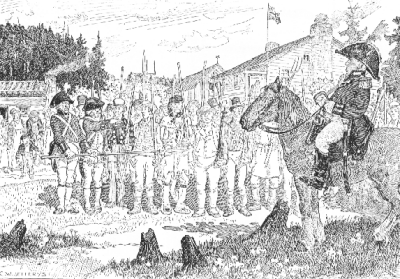 |
|
Militia Training Session |
No training was involved. The men simply "formed the line," following which they dispersed to the pub. Those who ridiculed the event failed to understand that the "training" was not really training at all. A muster parade simply served to keep the battalion roles active and up to date. Musters also reminded every citizen that as a militiaman, he was liable to be called out in time of crisis to defend his country.
A notice in the Niagara Herald dated May 23, 1801 inserted by Samuel Street, Deputy Lieutenant of Lincoln County, instructed the militia to meet at Chippawa Bridge on June 4th, King George III's birthday, a day of "rejoicing in the health of His Majesty." Unlawful absence resulted in a 10 shilling fine.
In 1807 the parade at Niagara included a reception by Lieutenant-Governor Gore, who first reviewed one thousand militiamen "formed in line on the plains." The Governor expressed the highest satisfaction with their conduct and carriage and thanked them for their alert appearance. They were ordered to be ready to march when "the exigencies of His Majesty's Service" required.
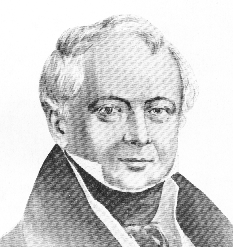 |
|
Francis Gore |
Actual militia training was not begun until 1808. Depending on one's age and physical condition, militiamen were divided into two groups: "embodied and sedentary." The well-named sedentary militia was a very cheap force to maintain for it existed only on paper for 364 days a year. Actual bodies were expected to match the numbers on the one day a year when they were mustered. Members of the sedentary militia were unorganized and untrained and usually employed as military labourers or guards. The embodied or active militia was composed of volunteers supplemented by ballot, that is, men chosen by lot. They were in better physical condition, received training and were frequently good enough to fight on the flank or along side regular troops.
Just prior to the commencement of the War of 1812, Lieutenant Governor Gore returned to England on leave. He was replaced by General Isaac Brock who became both administrative and military head of the province. In June 1812 before President James Madison declared war on Great Britain, the militia of Frontenac County was already drilling in Kingston. The Gazette reported "The Militia formed with troops composing the garrison and went through firing and other military evolutions, which they performed with the steadiness and precision of old Soldiers."
Brock agreed and stated In His Own Words"The Militia from the Bay of Quinte to Glengarry is the most respectable of any in the Province."
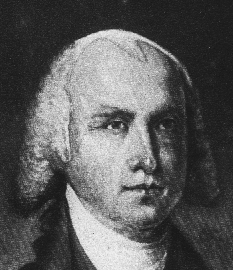 |
|
James Madison |
From 1794 until 1812 the militia was largely unchanged. Its basic unit was a company, comprised of 20 to 50 privates and three officers: a captain, a lieutenant and an ensign. At the commencement of the War of 1812, Major-General Isaac Brock had real reservations about the reliability of the volunteer force. In a letter to a friend he confided that militia officers had "succumbed to the inevitability of an American conquest." They were, he said, sluggish and indifferent and he fervently wished for an "additional regiment of regulars." But Brock knew the importance of praise and he never missed an opportunity to commend and congratulate the officers and men on their efforts.
In His Own Words"In the great points of our security and defence, I persuade myself one Heart and one Mind will actuate all. I trust the regular troops and the 'interior force of the country' shall be found equal to any attack that can be made on us. Animated by every motive that can excite them to resistance, our Militia will not be unmindful of the courage they displayed in former days."
Brock reinforced this praise in a speech to the Legislature when he said
In His Own Words"Our Militia have heard the voice of loyalty and obeyed it. They have evinced by the promptitude and Loyalty of their conduct that they are worthy of the King whom they serve and the Constitution which they enjoy."
In the Regimental Order Book of the 3rd York Regiment of Militia, Brock wrote: "Major-General Brock offers his high approbation of their orderly conduct and good discipline while under arms and says their exercise and marching far exceeds any he has seen in the Province." He stated how pleased he was "with appearance of the officers in uniform and their perfect knowledge of their duty."
Brock endeavoured to keep the men alert and ready for action as the following excerpt from the same Regimental Order Book indicates. "In consequence of an order from Major-General Brock, a detachment of volunteers under the command of Major Allan is to hold themselves in readiness to proceed in batteaux to the Head of the Lake to-morrow at 2 o'clock. The following officers, non-commissioned officers and privates will proceed for the purpose of being fitted with caps, blankets and haversacks as well as to draw provisions. On their arrival at the Head of the lake regimental coats and canteens will be ready to be issued to them."
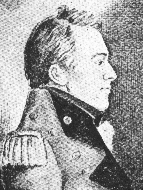 |
|
Isaac Brock |
During the War of 1812, the militia, which was comprised largely of Loyalists, was assigned transport and labour duties. Volunteers in the provincial regiments also fought alongside British regulars as "flank companies, that is, troops who were deployed on the sides of the regular troops. The strength of each flank company was limited to three officers, two sergeants, on drummer and thirty-five other ranks. Because there were no uniforms, Brock suggested that each man "provide himself with a short coat of some dark coloured cloth made to button well round the body and pantaloons suited to the season with the addition of a round hat." Officers were advised "on every occasion when in the field, to dress in conformity with the men in order to avoid the bad consequences of a conspicuous dress."
Brock's praise and preparedness paid off with the successful conquest of Detroit. This was to be the militia's first taste of fire and Brock was loud in his praise of the cheerfulness and constancy of "that gallant band," which included regulars, Native warriors and militiamen.
Men of the militia did their duty during the War of 1812. The Lincoln Militia were complimented by both Brock and Sheaffe. While some men in the colony who were obliged to fight never did so, the sedentary militia on the whole did what was expected of it - transporting supplies, building roads and fortifications, guarding prisoners and providing mounted couriers - very necessary tasks that required little or no military training. Some "very cautious citizens" served for only short periods, while others always responded when called upon. At Stamford when General Brock reviewed two companies of militia and asked how many would volunteer, they all marched to the front except one. Despite the passionate patriotism of some, fewer than half of the adult male population of Upper Canada actually fought in the war.
Militia officers were praised by General Sheaffe as "having particularly signalized themselves for the gallant and steady manner in which they led troops under their command into action and for the length of time they sustained conflict with an overwhelming enemy." Militiamen showed "exemplary bravery" at the bloody battles of Chippawa and Lundy's Lane. These were men "whose deeds spoke."
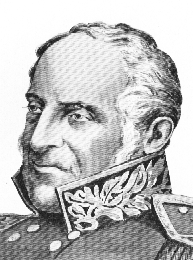 |
|
Roger H. Sheaffe |
They clearly demonstrated as Brock had earlier stated
In His Own Words"that a country defended by free men devoted to the cause of their king and constitution can never be conquered."
Provincial leaders attempted to utilize the new surge of patriotism in Upper Canada by founding The Loyal and Patriotic Society in December 1812. Its purposes were: (a) "to afford aid and relief" to militiamen and their families who suffered from distress because of the war; and (b) "to bestow medals for extraordinary instances of personal courage and fidelity in defence of the Province either by His Majesty's regulars or militia forces and seamen." Anyone in the province who contributed a pound or more annually could be a member. It was the intention of this society to present the medal below to all those who had "distinguished themselves" during the war. However, the medal was never issued because it would have been too expensive to award it to such a large number of deserving citizens.
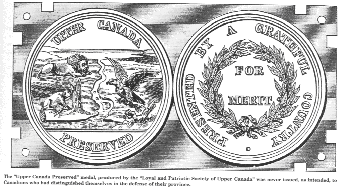 |
|
Upper Canada Recognizes Its Own |
No comprehensive record has been found of the losses suffered by Upper Canada's militia in this war. An incomplete list of pension applications exists which gives a total of 19 killed, 86 deaths on duty due to disease and 144 wounded. Anyone wounded in action was provided for out of public funds. Pensions were paid only to those incapacitated, and in the case of a soldier's death, his widow and minor children were compensated. Statistics regarding losses at the Battle of Queenston record that one rank and file of the Lincoln Artillery was wounded; one adjutant, one sergeant, and 12 rank and file of the Lincoln Militia were wounded; two rank and file of the York Militia were killed and one lieutenant, one sergeant and 15 rank and file of the York Militia were wounded.
By the end of the War of 1812, Upper Canadian pride in the wartime accomplishments of its militia provided a real sense of patriotism. Brock's policy of praising the militia was clearly the origin of what came to be called the "militia myth." In the minds of many Upper Canadians, this myth became the gospel truth. According to this belief, the American invaders were repulsed by the people's army, the Upper Canadian militia, which was assisted on occasion by a few hundred British regulars. The Canadian militia, not British regulars, saved Upper Canada from American conquest. This belief was well summarized in an address to the Prince Regent, George III's son, by the Legislature of Upper Canada at its spring session in 1814.
"When it is considered, may it please Your Royal Highness, that the whole male population of Upper Canada able to bear arms does not exceed ten thousand men, and it is scattered over a frontier of at least eight hundred miles in extent, when it is considered that nearly one-half of these were embodied for the whole of the first, and a very considerable proportion for the greatest part of the last campaign, and they composed the principal part of the force that successively captured the forces of Michilimackinac and the army of General Hull and which fought and gained the battle of Queenston, and when it is known that the greatest part of the transportation and provisioning of the Forces in Upper Canada fell on them, and that in such parts as have been visited by the enemy, their properties have been plundered and destroyed, and themselves as prisoners carried away, we think may it please Your Royal Highness, it will be admitted that the Militia of this Province have faithfully performed their duty and that their services have very largely contributed to the security of this part of His Majesty's dominions, and that it was the duty of the representatives of Our Sovereign to have laid before Your Royal Highness a faithful account of our services and our sufferings."
The Reverend John Strachan, a pillar of Upper Canadian society, considered the militia the bulwark of the colony's security and the main source of its power. He attributed the preservation of the province to the militia and in a sermon he predicted
In His Own Words"It will be told by future Historians that the Province of Upper Canada without the assistance of men or arms except a handful of regular troops repelled its invaders, slew or took them all prisoner and captured from its enemies the greater part of the arms by which it was defended. Historians will hail the heroic exertions that saved the country and write glowing accounts of their conflicts covered in glory."
Later Strachan added to the lore when he declared, "Never, never surely, was greater activity shown in any country than militia has exhibited; never greater valor, cooler resolution, and more approved conduct. They have twice saved their country."
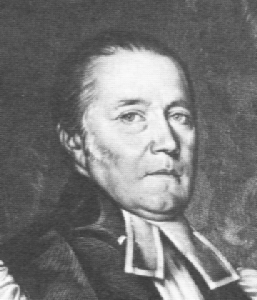 |
|
John Strachan |
Strachan's patriotic but problematic predictions were not generally shared by historians. While many historians agree that the militia played an important role in the war, most maintain that Canada was really saved by British redcoats. "However willing its members might be to face the enemy - and their zeal was often most intense - the members of the short-term militia were inevitably part-time soldiers, bound to drift away as harvest time approached or when word came that their families might be in danger from American raiding parties. Reliance had to be placed on regular troops and on local corps raised on terms approaching those governing the regular forces."
Sir George Prevost confirmed this in a report to London in 1813.
In His Own Words"For the preservation of the province, I have been forced to bring forward my best and reserved Soldiers to enable me to support the positions we hold on Niagara and Detroit Frontier. I have been induced to adopt this measure from further consideration that the Militia have been considerably weakened by the frequent desertions of even the well disposed part of them to their farms for the purpose of getting seed into the ground before the short summer of this country has too far advanced."
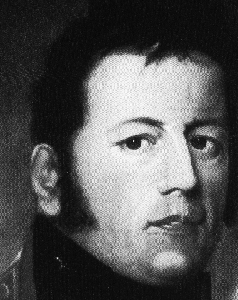 |
|
Sir George Prevost |
In fact, there were few occasions when the presence of part-time Canadian militia summoned from their fields for a week or two was indispensable. "While the British North American colonies were expected to maintain a militia, the cost of the defence burden in both peace and war was borne by the British taxpayer. Even in southern Ontario British regular troops were the mainstay of the defences." In the words of the Canadian historian C. P. Stacey, the successful defence of Canada was not due to "youngsters fresh from the tail of the plough," but to trained soldiers."
Peace naturally resulted in a relaxation of military effort. Regiments were disbanded on the grounds of economy and no improvements were made to the militia system. Universal military service remained in effect, but militiamen continued to be unarmed, untrained, and un-accoutred. The merry myth persisted, however, that militiamen led by amateur officers had thrown back the invader when the call of duty came. Canadian legend assigns full credit for our victories to the valiant men in the militia, who served with great distinction and bravery during that critical time in the life of our country.
Copyright © 2013 Website Administrator